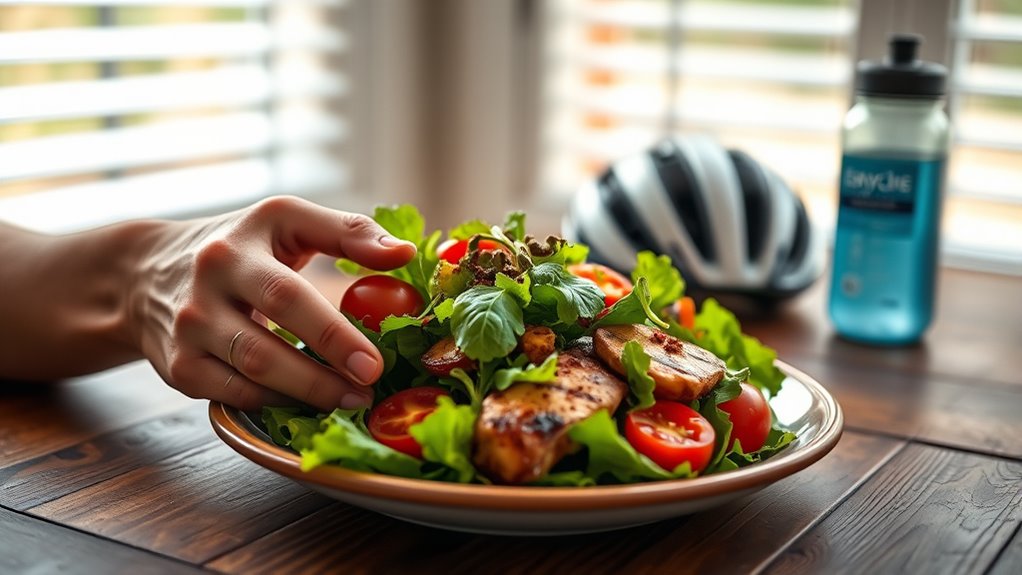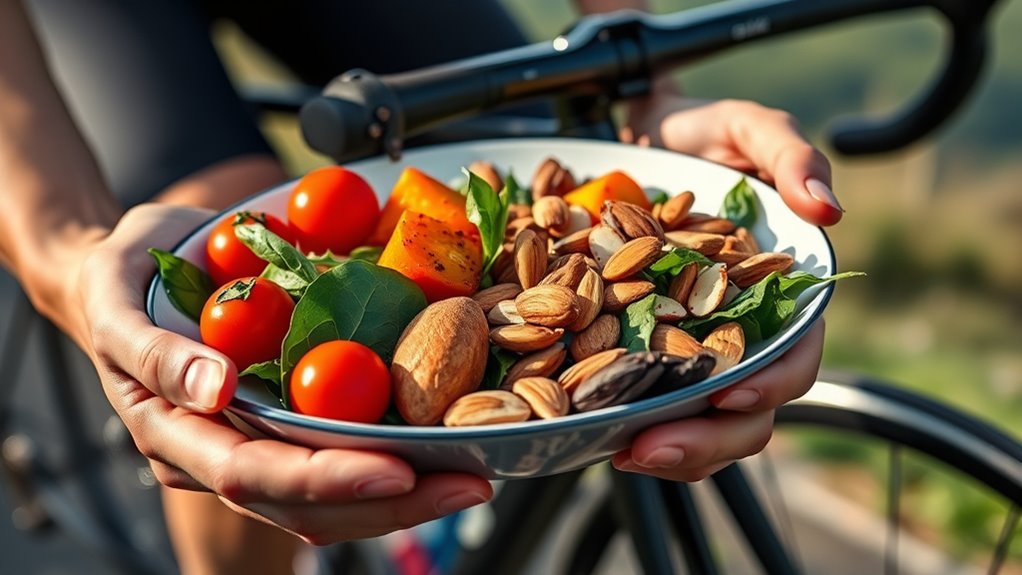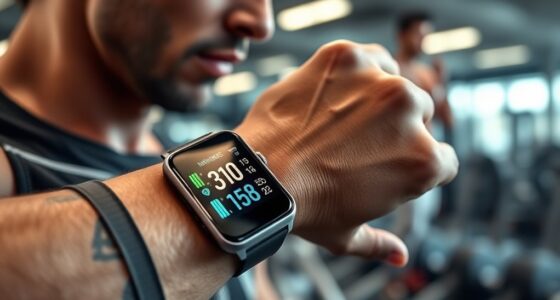To prevent weight-loss plateaus as a cyclist, practice mindful eating by tuning into your body’s hunger and fullness cues, and recognize emotional triggers that lead to overeating. Create a calm environment, eat slowly, and focus on savoring nutritious foods instead of distractions. Using smaller portions and paying attention to internal signals can boost satiety and energy levels. If you want strategies to stay on track and improve your performance, keep exploring these mindful habits.
Key Takeaways
- Practice mindful portion control by using smaller plates and adding vegetables for volume to prevent overeating.
- Tune into hunger and fullness cues before, during, and after meals to avoid plateaus caused by excessive intake.
- Focus on nutrient-dense foods like whole grains, plant proteins, and vegetables to sustain energy and support cycling performance.
- Create distraction-free eating environments to enhance awareness of eating habits and prevent impulsive overeating.
- Recognize emotional triggers that lead to unconscious eating, developing healthier responses to maintain consistent weight loss.
Understanding the Role of Mindfulness in Eating Habits

Mindfulness plays a crucial role in shaping your eating habits by encouraging you to pay full attention to what and how you eat. When you practice mindful snacking, you focus on each bite, savoring flavors and textures rather than eating mindlessly. This helps prevent overeating and fosters a healthier relationship with food. Similarly, mindful hydration involves being aware of your fluid intake, noticing thirst cues, and choosing beverages intentionally. By staying present during meals and snacks, you become more attuned to your body’s actual needs, reducing impulsive eating driven by boredom or stress. Incorporating mindful practices into your routine helps you develop a balanced approach, supporting your overall health and cycling performance without relying on restrictive diets or distractions. Live music at restaurants can also enhance your dining experience, making mindful eating more enjoyable and memorable. Paying attention to flavor profiles can also elevate your awareness of what you’re consuming, encouraging more satisfying and intentional choices. Additionally, creating a pleasant dining environment with aesthetic table linens can make the experience more engaging and help reinforce mindful habits. Engaging in positive reinforcement can further motivate consistent mindful eating habits, and understanding the importance of home essentials can help you prepare nourishing meals that support your health goals, making mindful choices easier to sustain over time.
Recognizing Hunger and Fullness Cues During Your Meals

As you eat, pay attention to your body’s signals to spot when you’re truly hungry or full. Recognizing these cues helps you avoid overeating and stay energized for your rides. Staying mindful during meals allows you to develop a better understanding of your body’s natural hunger rhythms and prevents overeating. Stay focused on your meal, and steer clear of distractions that can mask these important physical signals. Incorporating mindful eating techniques can also enhance your awareness of hunger and fullness cues, leading to better nutritional choices and improved performance. Being aware of how sound vibrations influence your state of mind can further support your focus and balance during meals. Additionally, understanding local resources and tools, such as regional legal and health resources, can provide support for maintaining your well-being and nutritional goals.
Tuning Into Body Signals
Tuning into your body signals is key to eating mindfully, especially when cycling regularly. Developing body awareness helps you notice subtle cues of hunger and fullness. Pay attention to sensory perception—how your stomach feels, the taste and texture of your food, and your overall energy levels. These signals guide you to eat when truly hungry and stop before overeating. Avoid distractions like screens or multitasking during meals, as they can dull your awareness of these cues. Incorporating mindfulness practices such as meditation or focused breathing can further strengthen your connection with internal signals, supporting healthier eating habits and preventing weight-loss plateaus. Being mindful of your nutritional intake can also help ensure you’re consuming adequate nutrients to support your cycling performance. Recognizing internal cues helps you tune into your body’s needs more accurately, fostering a more intuitive approach to eating. By consciously tuning into your body’s messages, you create a better connection with your internal signals, enhancing your ability to regulate your intake naturally. Over time, this heightened sensory perception helps you develop a more intuitive approach to fueling your cycling and daily life.
Recognizing Physical Hunger
Recognizing physical hunger is essential for fueling your cycling effectively and maintaining a healthy relationship with food. It helps you determine the right times to eat, supporting consistent energy levels. Pay attention to cues like a growling stomach, low energy, or slight irritability—these often signal genuine hunger. Proper meal timing ensures you don’t eat out of boredom or habit, which can lead to overeating. Practice portion control by serving enough to satisfy your hunger without excess. As you eat, check in with your body to see if you’re beginning to feel full before finishing your plate. Monitoring hunger and fullness cues can also help you better understand your body’s needs during pregnancy. Developing awareness of these signals over time encourages a more mindful approach, preventing unnecessary calorie intake and supporting your cycling performance. Incorporating body awareness techniques can further enhance your ability to listen to your body’s natural signals.
Avoiding Distraction Eating
Distractions during meals can easily cause you to lose track of your hunger and fullness cues, leading to overeating or undereating. To avoid this, practice distraction management by creating a calm eating environment. Put away your phone, turn off the TV, and focus solely on your meal. Mindful snacking is also helpful; take small bites and pay close attention to the taste, texture, and how your body feels as you eat. Check in with yourself regularly—pause between bites to assess your hunger level. By reducing distractions, you become more aware of your body’s signals, helping you eat just enough and prevent weight-loss plateaus. Over time, this mindful approach strengthens your connection to your body’s needs during every meal.
Identifying Emotional Triggers That Lead to Overeating

You might notice that emotions like stress or boredom often prompt you to eat more than you need. Recognizing these emotional cues helps you understand your triggers for overeating. Once you identify them, you can develop healthy ways to respond instead of turning to food. Incorporating mindfulness meditation into your routine can further support emotional regulation and prevent emotional eating episodes. Developing emotional awareness can enhance your ability to distinguish between physical hunger and emotional cravings, leading to more mindful eating habits. Being aware of grocery store hours can help you plan your shopping trips more effectively, reducing stress and impulsive eating. Additionally, understanding Halloween traditions can prepare you to navigate holiday temptations mindfully.
Recognizing Emotional Cues
Emotional triggers often drive overeating, subtly influencing eating habits even when physical hunger isn’t present. Recognizing these emotional cues is key to managing emotional eating effectively. Pay attention to feelings like boredom, frustration, or loneliness that may prompt you to eat without real hunger. Notice if certain situations, such as stressful rides or tight schedules, heighten your urge to snack. Developing awareness of these triggers allows you to distinguish between physical hunger and emotional cravings. Incorporate stress management techniques like deep breathing or mindfulness to reduce the impulse to eat emotionally. By identifying how emotions influence your eating patterns, you can make conscious choices and prevent emotional eating from sabotaging your weight-loss goals.
Common Triggers for Overeating
Many emotional triggers can lead to overeating, often without you realizing it. You might find yourself engaging in mindless snacking after a stressful day or during moments of boredom. Emotional eating is a common response to feelings like loneliness, frustration, or sadness, prompting you to seek comfort in food. Recognizing these triggers helps you become more aware of why you eat beyond physical hunger. For example, reaching for snacks out of habit rather than hunger often results in overeating. By understanding that emotions can drive your eating habits, you can start to pause and reflect before grabbing food. This awareness is essential for developing mindful eating habits that prevent unnecessary calorie intake and support your weight-loss goals.
Developing Healthy Responses
Recognizing emotional triggers is a essential first step in developing healthy responses to overeating. When you identify what prompts emotional eating—such as stress, boredom, or frustration—you can choose mindful snacking instead of mindless consumption. Practice being present during meals and snacks, paying attention to hunger cues and fullness levels. Incorporate intuitive hydration by listening to your body’s signals, drinking water when thirsty rather than out of habit or emotion. When emotional triggers arise, pause and ask yourself if you’re truly hungry or seeking comfort. Developing these healthy responses allows you to break the cycle of overeating, making it easier to maintain your weight goals. Over time, you’ll build resilience against emotional eating and foster a more balanced, mindful approach to food.
Incorporating Mindful Practices Into Your Daily Routine

To effectively incorporate mindful practices into your daily routine, start by setting aside a few moments each day to pause and tune into your body’s hunger and fullness cues. This helps you become more aware of genuine hunger, preventing mindless eating. Practice mindful snacking by choosing nutritious options and eating slowly, savoring each bite without distractions. Implement meal timing strategies, such as eating at regular intervals and avoiding skipping meals, to maintain energy levels and reduce overeating later. Before eating, take a deep breath and check in with your body to assess if you’re truly hungry. These small, intentional pauses make it easier to stay present during meals, foster healthier habits, and support your cycling performance and weight management goals.
Adjusting Portion Sizes for Optimal Energy and Satisfaction

Adjusting your portion sizes guarantees you get the right amount of energy without overeating, which is especially important for cyclists who rely on proper fueling. Practicing portion control helps prevent weight-loss plateaus and boosts satiety awareness, so you feel satisfied without excess. To fine-tune your intake, consider the following ideas:
| Small Portions | Larger Portions |
|---|---|
| Use smaller plates | Use larger plates cautiously |
| Serve slightly less | Add more vegetables for volume |
| Pause between bites | Listen to your body’s fullness cues |
Selecting Nutrient-Dense Foods to Support Cycling Performance

Choosing nutrient-dense foods is vital for fueling your cycling performance, as these foods pack essential vitamins, minerals, and antioxidants into every bite. Prioritize whole grains like oats and brown rice to provide sustained energy, and include plenty of plant proteins such as beans, lentils, and tofu to support muscle repair and recovery. These choices help keep you energized during long rides and prevent fatigue. Incorporate colorful vegetables and fruits to boost antioxidant intake, protecting your cells from oxidative stress. Remember, mindful selection of nutrient-dense foods guarantees you’re fueling your body efficiently, optimizing performance, and avoiding energy dips. Making these smart choices supports your cycling goals while promoting overall health and well-being.
Tracking Progress and Staying Motivated on Your Journey

Tracking your progress is essential for maintaining motivation and staying on course with your cycling goals. By regularly monitoring your performance, you can see tangible results and identify areas for improvement. Use tools like a cycling app, journal, or fitness tracker to log your rides, distances, and how you feel afterward. Celebrating small victories keeps you motivated and reinforces your commitment. Remember, progress isn’t always linear, so be patient and focus on consistent effort. Reflect on your achievements and setbacks honestly, adjusting your mindful eating habits as needed. Staying motivated requires a clear view of how far you’ve come, which fuels your determination to continue. Keeping track helps you stay accountable, inspired, and aware of your growth throughout your cycling journey.
Frequently Asked Questions
How Can Mindful Eating Improve Cycling Endurance?
You can improve your cycling endurance by practicing mindful eating, which helps you better recognize hunger and fullness cues. Focus on proper meal portioning and timing your snacks strategically around rides to maintain energy levels without overeating. This approach guarantees you fuel your body effectively, prevents fatigue, and enhances stamina. By being attentive to what and when you eat, you support sustained cycling performance and overall endurance.
What Are Common Obstacles to Practicing Mindful Eating Consistently?
You might struggle to practice mindful eating consistently due to eating distractions and the habit of mindless snacking. These obstacles can make it hard to focus on hunger cues and enjoy your food fully. To overcome this, you need to create a distraction-free environment and be intentional about your eating moments. Incorporating mindful snacking with awareness and slowing down can help you develop a more consistent mindful eating practice.
Can Mindful Eating Help With Managing Cravings After Long Rides?
Mindful eating can definitely help you manage cravings after long rides. By practicing craving awareness, you become more attuned to true hunger versus emotional eating. Mindful snacking allows you to choose nutritious options and enjoy them slowly, reducing overeating. When you pause to notice your cravings, you gain control and prevent unnecessary indulgences. This approach supports your recovery and keeps your energy levels steady, making it easier to stay on track with your cycling goals.
How Does Mindful Eating Affect Recovery Nutrition?
While recovery nutrition may seem like a simple task, mindful eating gently reminds you to focus on meal timing and portion control, ensuring your body gets the right nutrients when it needs them most. By paying close attention to hunger cues and eating slowly, you optimize nutrient absorption and reduce overeating. This thoughtful approach helps you recover faster, sustain energy, and maintain a healthy weight, all essential for your cycling performance.
Are There Specific Mindful Eating Techniques Suited for Athletes?
When it comes to mindful eating techniques for athletes, you should focus on mindful snacking and portion awareness. Pay attention to hunger cues before reaching for a snack, and choose smaller portions to avoid overeating. Slow down your eating, savor each bite, and stay present during meals. These habits help you fuel properly, prevent overconsumption, and support your athletic performance without guilt or distraction.
Conclusion
By practicing mindful eating, you can break through weight-loss plateaus and boost your cycling performance. Did you know that 70% of people who eat mindfully report improved satisfaction and better portion control? Staying aware of your hunger cues, emotional triggers, and food choices keeps you in control and energized. Keep tracking your progress and adjusting your habits—your body and bike will thank you for it. Embrace mindfulness and enjoy the ride to your best self!









